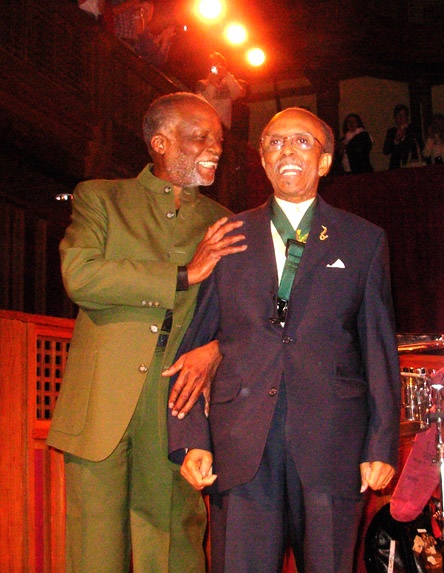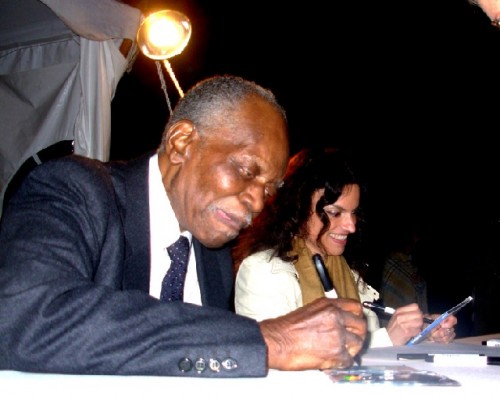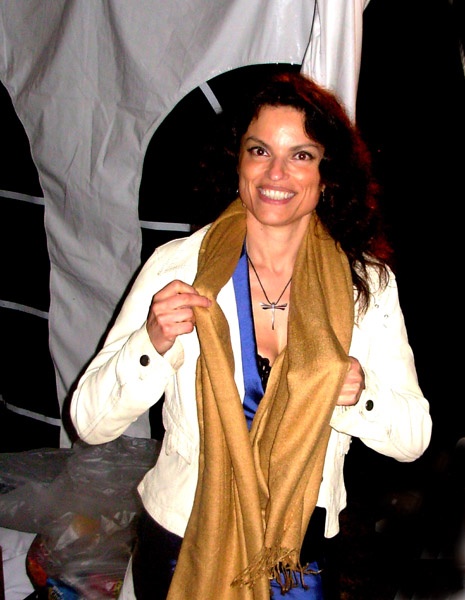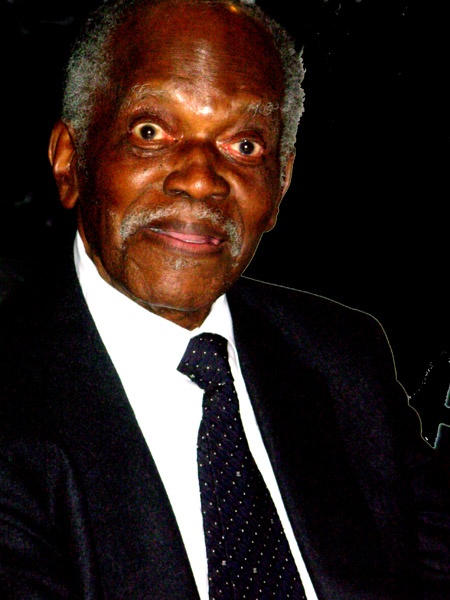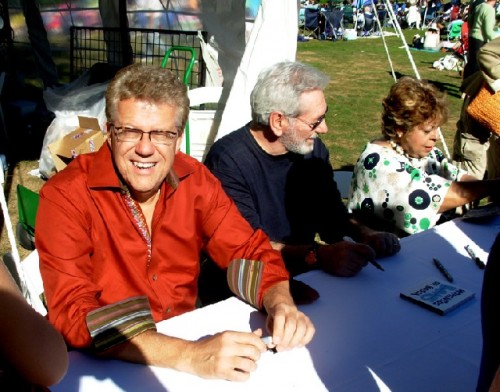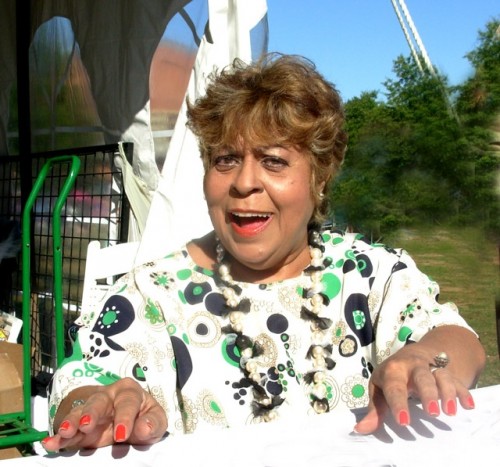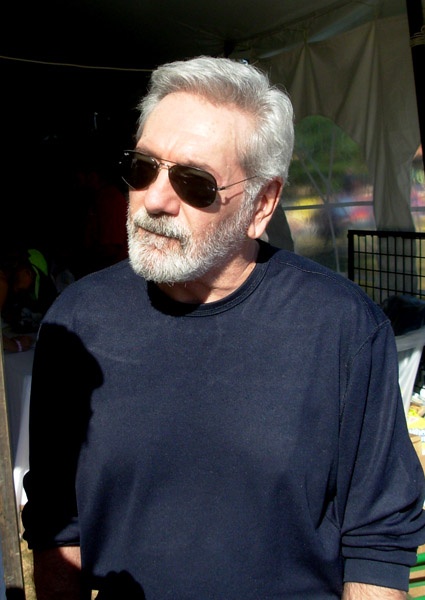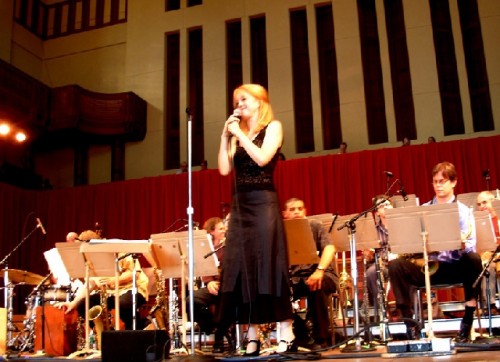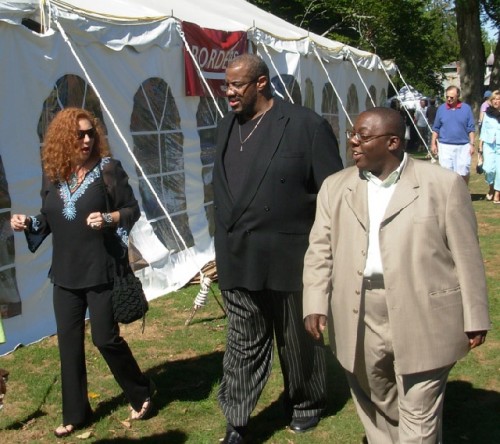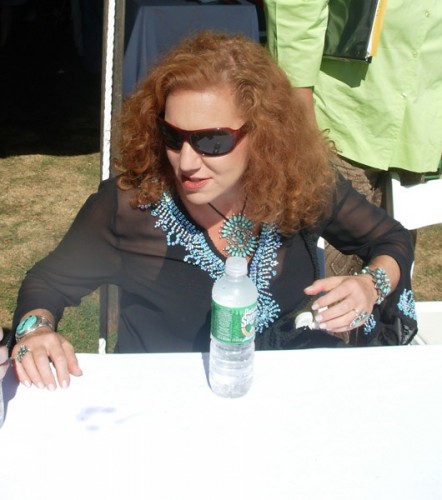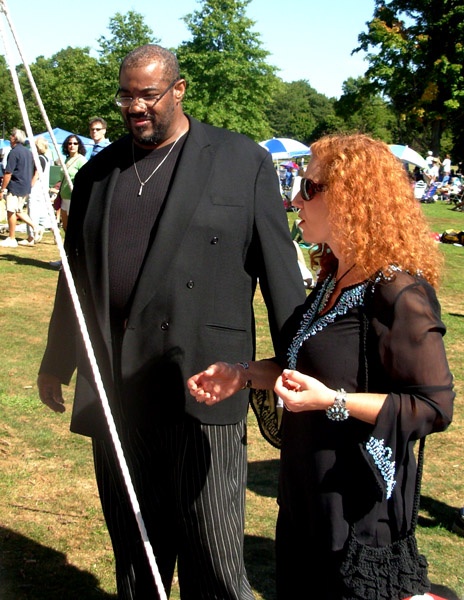Tanglewood Features: Ahmad Jamal and Jimmy Heath, Hank Jones and Roberta Gambarini, The Maria Schneider Orchestra, Bossa Brazil, and Kevin Mahogany's Kansas City Revue
Day Three of the Tanglewood Jazz Festival
By: Charles Giuliano - Sep 03, 2007
Three's a charm as Summer came back for an encore with a glorious final day of Labor Day Weekend's Tanglewood Jazz Festival. After a deep freeze on Saturday it was back to the shorts and tank tops on Sunday as a surge of fans, lured by the buzz of rave reviews for the music and holiday party ambiance, swarmed around packed Ozawa hall. They spread blankets and lawn chairs as far as the eye can see. Now in its third year of ending the season in Lenox this is by far the most successful in a series which is fast becoming a Berkshire tradition thanks to the superb programming of legendary jazz entrepreneur Freddy Taylor.
The boffo success of the Tanglewood Jazz Festival makes a compelling argument for inserting more of this popular programming into the mainstream of the Tanglewood offerings and beefing up the "shoulder seasons" which occur before and after high season. Jazz is perfect for the Lenox based summer home of the Boston Symphony Orchestra. There is concern in some stodgy quarters that diversifying with jazz and blues vulgarizes the venerable institution and threatens to turn it into another Woodstock. These snobs just don't get the point that Jazz is America's greatest indigenous art form.
Yesterday we hunkered down with a series of concerts that started at 1:30 in the afternoon and stretched out to just about midnight with a dinner break in between. The evening headlined pianist Ahmad Jamal jamming with sax player Jimmy Heath. The duo of Italian born singer, Roberta Gambarini, accompanied by pianist Hank Jones, opened for Jamal with a subdued and absorbing set.
The day long performances started with an expansive Kevin Mahogany who matched the legendary Kansas City Blues singer, Big Joe Turner, on every level from girth to grit. The performance in tribute to Turner touched on all aspects of the unique Kansas City sound that spawned the Count Basie Band and the beginnings of Charlie Parker as well as a unique style of boogie woogie piano.
While the Mahogany set was billed as a Turner tribute at times it seemed like he was taking note for note and riff for riff from the seminal Lambert, Hendricks and Ross (with Joe Williams) album with Count Basie. This was particularly evident on his version of the standard "Goin' To Kansas City." He was joined by a flame headed belter, Kathy Kousins, who did a nice job with "Morning Glories" and the wonderful funk of the sax player Red Holloway. We particularly enjoyed the Kansas City piano style of the formidable Cyrus Chestnut. The crowd got into it and demanded an encore. Here Mahogany threw away the Tribute and got down and dirty with a soulful version of "Send Me Someone To Love."
After the rousing opening of Mahogany's expansive and boisterous set the mood was more subdued when the program shifted to Brazilian music with a trio Bossa Brazil. Guitarist Romero Lubambo, who had performed a stunning duet with the singer, Kurt Elling, the evening before was paired with pianist Cesar Camargo Mariano a founder of the Bossanova sound. Mariano is noted for producing hundreds of Brazilian stage and screen personalities, musicians, orchestras and ensembles. Lubambo is a younger, Brazilian player with classical training who lives in New York where he is a co-founder of Trio de Paz with Duduka de Fonesca and Nilson Matta. Lubambo and Mariano jammed and shared some riffs before introducing the vocalist Leny Andrade who is known as the "Queen of Bossanova." She conveyed a regal presence moving slowly and gracefully onto the stage. Everything about her was unctuous, sensual and absorbing. It felt less like attending a performance than the privilege of being granted an audience with a Queen. We genuflected before serene offerings of vintage Bossanova. This was the music at its very best. But perhaps its low key intimacy and complex polyrhythm played better inside Ozawa hall than projected onto the surrounding lawn where one could not view her subtle nuances of movement and gesture.
The final set of the afternoon featured the young and beautiful Maria Schneider leading a big band. How rare is that? They opened with "Evanescence" the title track of her first album and a tribute to arranger Gil Evans for whom she worked as an assistant. She was with him on several projects including the sound track for the Martin Scorsese film "The Color of Money." In 1993 she started her Orchestra with a weekly gig in Greenwich Village. It is a tribute to her success that many of the original players still tour with her all over the world. She has received numerous commissions for new compositions as well as to arrange and conduct concerts including, among others, harmonica player Toots Thielmans, the Metropole Orchestra, The Stuttgart Jazz Orchestra, Orchestre National de Jazz, The Monterey Jazz Festival, Hunter College and Jazz at Lincoln Center.
The works that the orchestra performed reflects a post Gil Evans, modernist but mainstream sound with great attention to color and texture. Much of the music is literary and descriptive rather than abstract. The pieces are about specific responses to sources of inspiration. This is an embedded jazz tradition which started with the very first jazz recordings "Livery Stable Blues" by the Original Dixieland Jazz Band and was much a part of the oeuvre of Duke Ellington with such extended "symphonic" compositions as "Black, Brown and Beige" "The Liberian Suite" "A Drum is a Woman" or "Such Sweet Thunder." But one also hears in Schneider aspects of the avant-garde experiments of band leaders and arrangers such as Woody Herman, Stan Kenton, Alec Wilder, Johnny Richards (particularly his "Annotations of the Muses") and Don Ellis.
While Schneider draws on these diverse traditions the music she creates is also unique and personal. Dare I say this? There is a feminine touch. Meant in the best sense as an easy charm, and engaging prettiness. The writing never backs off from being beautiful. She often informed the audience of the sources and inspirations for the works. She described being in a car back home in South West Minnesota and begging her dad to take a particular road home, over a hill, when they drove home from a family outing at a restaurant. The hill, which apparently is rare in the prairie, afforded an evening view of their home town, Windham, with its population of some 3,600 souls. She described seeing the flickering lights and windows of homes as well as the night sounds of nesting birds. The piece evoked memories including hints of the music of that era. She informed her parents that she planned to include their favorite song but backed off when her mom said that would be "Hernando's Hideaway." She commented that it put her in "Therapy to discover that I was conceived to the music of Hernando's Hideaway. I know it is inappropriate to say that but I am working on it with my therapist." What followed was the rich and lilting "Pretty Road" with a solo by Ingrid Jensen switching off between trumpet and flugelhorn. There was also masterful solo work from Scott Robinson who commands an array of reed instruments.
The most successful and resonant work of the evening was "Sky Blue" the title track of the new CD. Commissioned by Hunter College it was written while spending time with a friend who succumbed to breast cancer. Another piece "Hang Gliding" was a literal interpretations of experiencing the extreme sport while touring in Brazil.
After a dinner break we returned for the evening program. Compared to the Shed, Ozawa Hall hold a more intimate audience of some 1,000. But the mood created by the duet of the stunning and sensual Roberta Gambarini, accompanied by pianist Hank Jones, called for an ever more cozy setting. Ideally, you wanted to experience this performance in a cabaret. While we were fairly close and drawn in by the experience one wondered how that projected way back on the lawn. This was the jazz equivalent of chamber music but in an expansive festival setting.
Ganbarini is a very literal interpreter of the songs in which lyrics and poetry are of primary importance. She belongs to the tradition of story tellers like Lena Horne and Carmen McCrae or Blossom Dearie. She can also open it up and riff or scat like Ella Fitzgerald or Anita O'Day. A glamorous woman, she appeared in a shimmering blue, tailored pants suit, with the jacket opened to reveal black lace. There is a prettiness and beauty about her manner of delivery. Her every gesture and note reeked of seduction. She didn't just perform but rather seduced the audience. This included some warm and affectionate flirting with her formidable accompanist.
While Gambarini can belt it out as she did last year with the recreated Dizzy Gillespie Big Band, on this occasion, we were invited to relax in her boudoir of songs. She started as a virgin conveying to a lover that "I Hadn't Anyone Till You." It was an enticing metaphor to begin an evening of sexy lyrics. She told us that it was a lifetime long dream to perform with Hank Jones as she followed with Johnny Mandel's "You Are There." This led to Benny Carter's "When the Lights Are Low," Johnny Mercer's "Fools Rush In," and "My Romance" by Rogers and Hart. Taking a break from all the romantic tunes she showed another side of her craft performing a surprising Irving Berlin song on the racist theme of the lynching of black men in the South. The song "Suppertime" apparently predated "Strange Fruit" the masterpiece performed by Billie Holiday. It poignantly conveyed the sorrow of a woman preparing a meal for the family in which her husband, who has been murdered by a mob, won't attend. The song was a hit for Ethel Waters. It was a stunning and galvanic moment in a set of mellow ballads which returned with the Ellington/ Strayhorn masterpiece "Lush Life." Later in the set she performed another Duke Ellington classic, originally recorded with the Gospel singer, Mahalia Jackson, the spiritual "Come Sunday." She performed a Hank Jones original "Centerpiece" as well as 'Lullaby in Rhythm" and "My One and Only Love." Gambarini ended the set with a scat and vocalese tribute to three instrumental solos by Dizzy Gillespie, Sonny Rollins, and Sonny Stitt arranged as a medley of "Sunny Side of the Street." Ending a set of subdued crooning she opened up and showed her bop chops. The girl can swing. The audience brought her back for an encore of "Mercy Mercy."
The Festival ended with a high key, flat out funky and groovy set by pianist Ahmad Jamal. In a quote that seems particularly relevant to the ambiance of Tanglewood the 77-year-old Jamal has gone on record stating that "I don't call myself a jazz musician. I've studied too long for that. I consider my music to be American Classical Music. In fact, I personally coined that phrase because jazz ill defines what we're doing. Yon must know Mozart, Duke Ellington, Franz Liszt, Beethoven, Count Basie and Art Tatum. We're not one-dimensional musicians and that is the challenging thing about American Classical Music and what they refer to as Jazz." Yeah baby.
Man what a set. He was accompanied by a powerful trio with Jamas Cammack on bass and drummer Idris Muhammed augmented on this occasion by the total gonzo percussionist Manolo Badrena. He provided just the right accent to all the complex mood swings and rhythmic changes. Often he seemed deranged as he reacted to the music with over the top gestures. The mood was infectious. Just when it seemed that a tune was winding down and about to end, with a flourish, Jamal would get into a new riff that would change and expand into something else. It was like those Keith Jarrett improvisations but without the pretentiousness. Jamal was having a ball. He finally took a break long enough to introduce his original piece "Papillon" which he explained means "Butterfly." With a bit of teasing he said that he would not perform his best known piece "Poinciana," from 1958, unless we begged for it. He then offered an updated version of the song with its infectious and much imitated drum inflections and Latin flavored textures. It is one of the all time catchy tunes and Jamal appears to still have fun with it.
He performed a Jimmy Heath song "Mellow Drama" which he recently performed with the Chicago Symphony. With that he brought out "The one and only Jimmy Heath." The sax player commented that "Ahmad took that song from me and I haven't performed it since. But it is a great to have the opportunity to play with a master and here is a tune by another master, Billy Strayhorn's, "Day Dream." " He performed on soprano sax and continued with Jamal's "Picture Perfect." He switched to tenor introducing his "Winter Sleeve" which is based on "Autumn Leaves."
How appropriate to wind down Labor Day Weekend with a riff on "Autumn Leaves." Spring forward but fall back. Soon there will be frost on the pumpkin. Cool. But in this last gasp of the summer of 2007 it was great to get a groove on.

